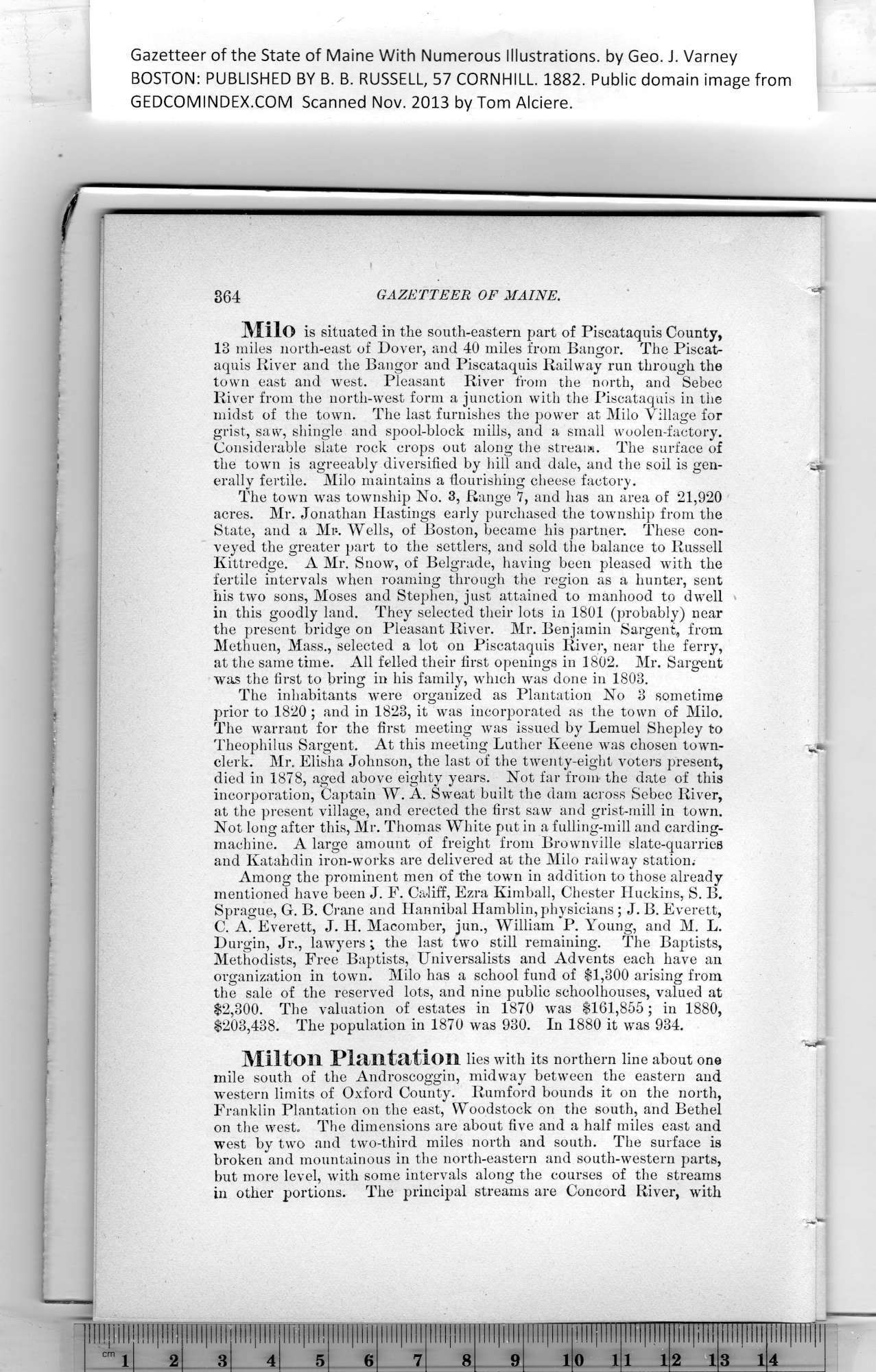|
Gazetteer of the State of Maine With Numerous Illustrations, by Geo. J. Varney
BOSTON: PUBLISHED BY B. B. RUSSELL, 57 CORNHILL. 1882. Public domain image from
364 GAZETTEER OF MAINE.
Milo is situated in the south-eastern part of Piscataquis County,
13 miles north-east of Dover, and 40 miles from Bangor. The Piscat-
aquis River and the Bangor and Piscataquis Railway run through the
town east and west. Pleasant River from the north, and Sebec
River from the north-west form a junction with the Piscataquis in the
midst of the town. The last furnishes the power at Milo Village for
grist, saw, shingle and spool-block mills, and a small woolen-faetory.
Considerable slate rock crops out along the stream. The surface of
the town is agreeably diversified by hill and dale, and the soil is gen-
erally fertile. Milo maintains a flourishing cheese factory.
The town was township No. 3, Range 7, and lias an area of 21,920
acres. Mr. Jonathan Hastings early purchased the township from the
State, and a Mi*. Wells, of Boston, became his partner. These con-
veyed the greater part to the settlers, and sold the balance to Russell
Kittredge. A Mr. Snow, of Belgrade, having been pleased with the
fertile intervals when roaming through the region as a hunter, sent
his two sons, Moses and Stephen, just attained to manhood to dwell
in this goodly land. They selected their lots in 1801 (probably) near
the present bridge on Pleasant River. Mr. Benjamin Sargent, from
Methuen, Mass., selected a lot on Piscataquis River, near the ferry,
at the same time. All felled their first openings in 1802. Mr. Sargent
was the first to bring in his family, which was done in 1803.
The inhabitants were organized as Plantation No 3 sometime
prior to 1820; and in 1823, it was incorporated as the town of Milo.
The warrant for the first meeting was issued by Lemuel Shepley to
Theophilus Sargent. At this meeting Luther Keene was chosen towm-
clerk. Mr. Elisha Johnson, the last of the twenty-eight voters present,
died in 1878, aged above eighty years. Not far from the date of this
incorporation, Captain W. A. Sweat built the dam across Sebec River,
at the present village, and erected the first saw and grist-mill in town.
Not long after this, Mr. Thomas White put in a fulling-mill and carding-
machine. A large amount of freight from Brownville slate-quarries
and Katahdin iron-works are delivered at the Milo railway station;
Among the prominent men of the town in addition to those already
mentioned have been J. F. Califf, Ezra Kimball, Chester Huckins, S. B.
Sprague, G. B. Crane and Hannibal Hamblin, physicians ; J. B. Everett,
C. A. Everett, J. H. Macomber, jun., William P. Young, and M. L.
Durgin, Jr., lawyers; the last two still remaining. The Baptists,
Methodists, Free Baptists, Universalists and Advents each have an
organization in town. Milo has a school fund of $1,300 arising from
the sale of the reserved lots, and nine public schoolhouses, valued at
$2,300. The valuation of estates in 1870 was $161,855; in 1880,
$203,438. The population in 1870 was 930. In 1880 it was 934.
Milton Plantation lies with its northern line about one
mile south of the Androscoggin, midway between the eastern and
western limits of Oxford County. Rumford bounds it on the north,
Franklin Plantation on the east, Woodstock on the south, and Bethel
on the west. The dimensions are about five and a half miles east and
west by two and two-third miles north and south. The surface is
broken and mountainous in the north-eastern and south-western parts,
but more level, with some intervals along the courses of the streams
in other portions. The principal streams are Concord River, with
PREVIOUS PAGE ... NEXT PAGE
This page was written in HTML using a program written in Python 3.2
|
